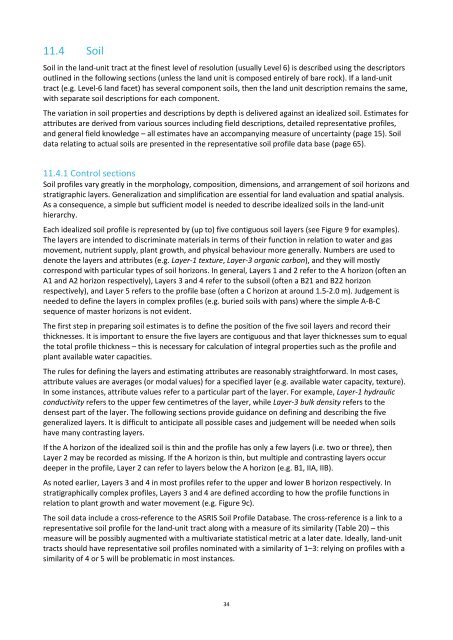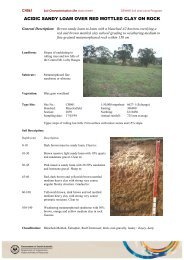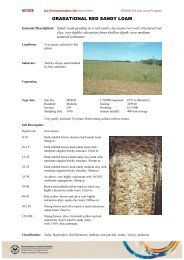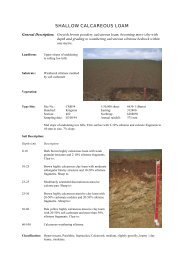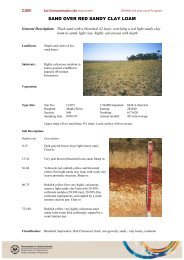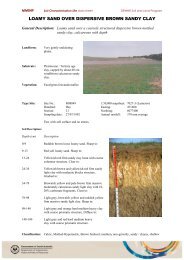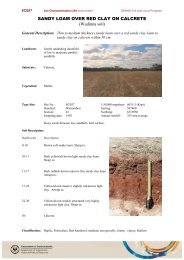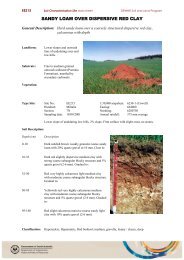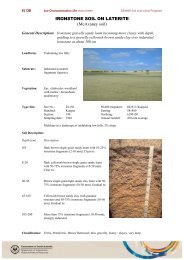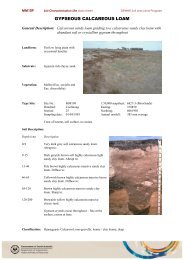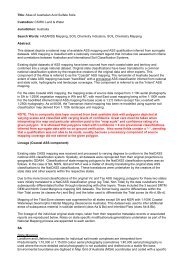Create successful ePaper yourself
Turn your PDF publications into a flip-book with our unique Google optimized e-Paper software.
11.4 SoilSoil in the land-unit tract at the finest level of resolution (usually Level 6) is described using the descriptorsoutlined in the following sections (unless the land unit is composed entirely of bare rock). If a land-unittract (e.g. Level-6 land facet) has several component soils, then the land unit description remains the same,with separate soil descriptions for each component.The variation in soil properties and descriptions by depth is delivered against an idealized soil. Estimates forattributes are derived from various sources including field descriptions, detailed representative profiles,and general field knowledge – all estimates have an accompanying measure of uncertainty (page 15). Soildata relating to actual soils are presented in the representative soil profile data base (page 65).11.4.1 Control sectionsSoil profiles vary greatly in the morphology, composition, dimensions, and arrangement of soil horizons andstratigraphic layers. Generalization and simplification are essential for land evaluation and spatial analysis.As a consequence, a simple but sufficient model is needed to describe idealized soils in the land-unithierarchy.Each idealized soil profile is represented by (up to) five contiguous soil layers (see Figure 9 for examples).The layers are intended to discriminate materials in terms of their function in relation to water and gasmovement, nutrient supply, plant growth, and physical behaviour more generally. Numbers are used todenote the layers and attributes (e.g. Layer-1 texture, Layer-3 organic carbon), and they will mostlycorrespond with particular types of soil horizons. In general, Layers 1 and 2 refer to the A horizon (often anA1 and A2 horizon respectively), Layers 3 and 4 refer to the subsoil (often a B21 and B22 horizonrespectively), and Layer 5 refers to the profile base (often a C horizon at around 1.5-2.0 m). Judgement isneeded to define the layers in complex profiles (e.g. buried soils with pans) where the simple A-B-Csequence of master horizons is not evident.The first step in preparing soil estimates is to define the position of the five soil layers and record theirthicknesses. It is important to ensure the five layers are contiguous and that layer thicknesses sum to equalthe total profile thickness – this is necessary for calculation of integral properties such as the profile andplant available water capacities.The rules for defining the layers and estimating attributes are reasonably straightforward. In most cases,attribute values are averages (or modal values) for a specified layer (e.g. available water capacity, texture).In some instances, attribute values refer to a particular part of the layer. For example, Layer-1 hydraulicconductivity refers to the upper few centimetres of the layer, while Layer-3 bulk density refers to thedensest part of the layer. The following sections provide guidance on defining and describing the fivegeneralized layers. It is difficult to anticipate all possible cases and judgement will be needed when soilshave many contrasting layers.If the A horizon of the idealized soil is thin and the profile has only a few layers (i.e. two or three), thenLayer 2 may be recorded as missing. If the A horizon is thin, but multiple and contrasting layers occurdeeper in the profile, Layer 2 can refer to layers below the A horizon (e.g. B1, IIA, IIB).As noted earlier, Layers 3 and 4 in most profiles refer to the upper and lower B horizon respectively. Instratigraphically complex profiles, Layers 3 and 4 are defined according to how the profile functions inrelation to plant growth and water movement (e.g. Figure 9c).The soil data include a cross-reference to the <strong>ASRIS</strong> Soil Profile Database. The cross-reference is a link to arepresentative soil profile for the land-unit tract along with a measure of its similarity (Table 20) – thismeasure will be possibly augmented with a multivariate statistical metric at a later date. Ideally, land-unittracts should have representative soil profiles nominated with a similarity of 1–3: relying on profiles with asimilarity of 4 or 5 will be problematic in most instances.34


